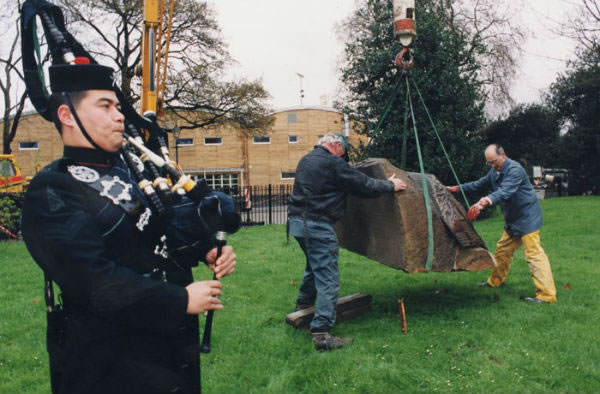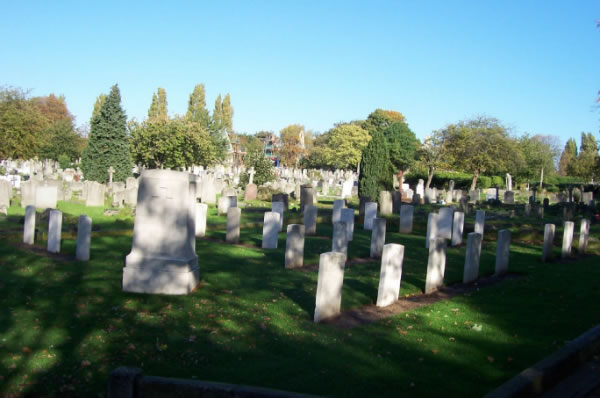Memorial to Gallipoli Fallen Unveiled in Wandsworth Cemetery
Troops died of wounds in local hospital

Royal Gurkha Rifles piper plays as the Bondi Beach rock and bronze relief of the Gallipoli battlefield arrive
The borough’s long-standing links with the wartime sacrifices made by troops from Australia and New Zealand are to be renewed at a ceremony this Tuesday (9 July) in memory of those who fell in the First World War’s Gallipoli campaign.
A commemorative bench will be unveiled in a part of the cemetery that is the final resting place of Australian soldiers who were wounded and ultimately succumbed to their injuries as a result of the ill-fated campaign to capture the Dardanelles. Some of those who had been wounded on the Allied side were brought by hospital ship to the UK for treatment at the military hospital housed in the Royal Victoria Patriotic Building on Wandsworth Common.
Of those who succumbed to their wounds, a number are now buried in Wandsworth Cemetery off Magdalen Road. They include cavalryman Trooper Joseph Betro of the 9th Australian Light Horse, who passed away on October 26, 1915. He grew up in Broken Hill, New South Wales and died at the age of 20.

Joseph Betro's body lies alongside comrades from the Gallipoli campaign
The campaign involved a joint naval and amphibious landing around the Dardanelle Straits in modern-day Turkey which was designed to knock the Ottoman Empire out of the war.
The battle, which raged from April 1915 to January the following year, ended in defeat for the Allies and resulted in heavy casualties among troops from Britain, Australia, New Zealand, France, India and Canada. The Ottoman forces suffered similarly grievous losses.
Joseph and other Australian comrades who rest in the cemetery, along with the fallen from all the other nations involved, will be the focus of the unveiling which is to be attended by representatives of the Governments of Australia, New Zealand, France, Turkey, India and Canada, together with representatives of the borough’s armed forces reserve units. The memorial seat will be officially unveiled by the Mayor of Wandsworth Cllr Jane Cooper.
Funding for the seat has been raised by the Gallipoli and Dardanelles International (G&DI), a charitable organisation dedicated to preserving the memory of those who fought and fell in the campaign, along with the British branch of the French organisation, the Association des Mutilés et Anciens Combattants, plus the council’s leisure and culture contractor Enable.
For many years Wandsworth’s links to Australia and New Zealand centred on Battersea Park being used to stage London’s annual Anzac Day Memorial Service.
The ceremony – held at dawn each year on April 25 to honour the war losses of both nations - was held at the park’s Royal Australian Air Force Remembrance Stone - the only one of its kind in London and dedicated to the sacrifice of 5,397 Australian airmen who lost their lives in action in the skies above Europe during the Second World War.
Wandsworth staged this annual remembrance ceremony every year from 1995 until 2003 when a new memorial was unveiled in Hyde Park and the ceremony moved there.
Battersea Park’s links to the two nations was further reinforced in 2000 when a new Anzac memorial was unveiled - a bronze plaque showing a map of the Gallipoli battlefields. It is mounted on a sandstone boulder weighing three quarters of a tonne which was flown to London from Sydney’s Bondi Beach by newspaper magnate Rupert Murdoch.
The boulder, which had been languishing on a disused golf course next to Australia's world-famous beach and landmark cliffs, was one of six flown to London by Mr Murdoch’s media company News Limited.
One was used for the memorial while the other five were placed in an enclosure in the park used to house a group of wallabies which were the descendants of those given to Her Majesty The Queen by the Australian Government to mark her coronation in 1953.
Wandsworth’s Mayor Cllr Jane Cooper said: “I hope this ceremony and the memorial stone seat that will be unveiled that day will serve as a poignant memorial to young Joseph Betro, his comrades who lie alongside him in Wandsworth Cemetery and all those who perished in this bitterly-fought campaign. We should never forget the sacrifices they made.
“We hope that whenever people visit the cemetery they will seek out the memorial to pay their respects and we also hope it may encourage local schools to explore the history of this battle and perhaps uncover the stories behind the lives of the young men who fought and died there and for whom Wandsworth has become their final resting place.”
July 9, 2019